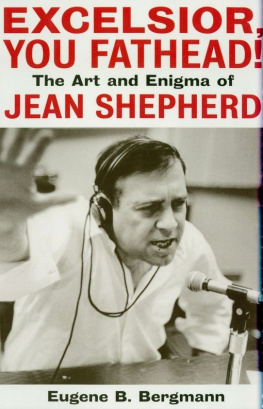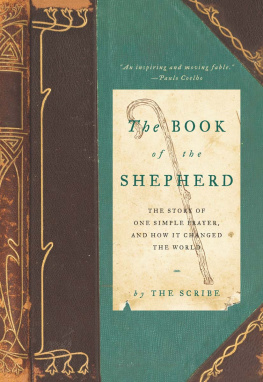ACKNOWLEDGEMENTS
I am especially grateful to Matthew Callan, who, while an editor at Applause Books, discovered Excelsior, You Fathead! through the website www.flicklives.com and championed the book with Applauses former CEO John Cerullo. (They are both big Shepherd enthusiasts.) Matt, with his varied interests in radio, jazz, and other areas of popular culture, his considerable knowledge of Jean Shepherd material, and his editorial eye, proved a valuable asset. He did research at WGBH Bostons facilities on Shepherds television work, and he contributed several observations about that material, and offered other comments for this book. I appreciate what Matthew Callan and John Cerullo have donewithout them, this book might not have seen the light of day.
My cousin and good friend, Raymond B. Anderson, got me to think more clearly about the crucial early chapters of this book and prodded me into probing more deeply into what Jean Shepherd said over the years. Regarding the entire book, he asked the right questions, clarified my thinking about organization and content, and helped me eliminate innumerable stylistic gaffs. I take credit for any remaining gaffs.
Special thanks to my long-time good friend Margaret Cooper for contributing her keen editorial eye at the eleventh hour.
Thanks to the college classmate (whose name I no longer remember) who first told me about the fascinating guy talking late into the night on the radio. Thanks to my friend Bill Hartland, who reminded me that I had made reel-to-reel recordings of Shepherd in the 1950s, thus jump-starting my renewed interest when Shepherd died in 1999. Thanks to numerous people who responded favorably to my early comments on Shepherd, thus increasing my enthusiasmand leading me to write the book I knew should be written.
Special thanks for many assistsincluding comments, information, and audio dubsgo to Jeff Beauchamp, Jim Clavin, Max Schmid, and Lowell Thelin. Most of my transcripts were made from Max Schmids Mass Backwards WBAI radio broadcasts, cassettes available for sale by him, and from the extensive collection of broadcast recordings available from Jeff Beauchamps The Jean Shepherd Project. Jim Clavin, with his Jean Shepherd website, www.flicklives.com, provides access to all the sources of Shepherd material. Flicklives also contains enormous quantities of other information, articles, etc., by and about Shepherdthis book is indebted to the online archives of Flicklives. Pete Delanys voluminous files of Shepherd material found on www.flicklives.com frequently provided necessary references.
Interviews, correspondence, commentary, and personal stories about Jean Shepherd are acknowledged for the following people: Bob Alden, David Amram, Fred Barzyk, Dan Beach, Bob Brown, Ron Della Chiesa, Billy Collins, Ed Fancher, Barry Farber, Mort Fega, Jules Feiffer, Helen Gee, Murphy Grimes, Hugh M. Hefner, Martin Jackson, Larry Josephson, Paul Krassner, Dan List, Norman Mailer, Bill Pasternak, Brian Pearson, Herb Saltzman, Scott Schwartz, Randall Shepherd, Herb Squire, Laurie Squire, Jerry Tallmer, Oliver Trager, Dan Wakefield, John Wilcock, and Pete Wood.
Interviews were taped with permission; as with the mail correspondence, the subjects understood that their words were going to be used in this book. As in any conversation, themes sometimes mentioned early on in an interview came up later in the talk. Where this ran counter to the presentation of an idea, the quoted material has been arranged to make a logical sequence. In no case has this, or the editing out of superfluous material, altered an intended meaning.
Ray Carney, author of several books about filmmaker John Cassavetes, Cassavetes on Cassavetes; Shadows; and John Cassavetes: The Adventure of Insecurity, provided information about the important role Shepherd played in launching Cassavetes career (see Chapter 6). Carney maintains a website, www.Cassavetes.com, with additional information.
Shepherd would sometimes comment that he had received a piece of information from one of his spies. Spies for this book who provided information and comments toward an understanding of the art of Jean Shepherd are acknowledged in the endnotes and include: Rich Badagliacca, Kerr Lockhart, and Brian Pearson. Thanks to all the members of shep@yahoogroups.com who shared information, opinions, and enthusiasm with the groupand thus, unknowingly enrich this book. And thanks to all of the Shepherd fans who taped, preserved, and made his programs available to the world at large.
A number of people and organizations helped me obtain images for this book without charge. For this, thank you to the following. Raymond B. Anderson took the author photo and provided it. Dan Beach provided his photo of Jean Shepherd, Leigh Brown, and Fred Barzyk. Bill Griffith provided his Zippy the Pinhead tribute to Shepherd. Donald A. Hamburg obtained permission from the Shel Silverstein estate to use the Look, Charlie playbill cover and the Shepherd LP cover drawing. Andy Paley gave permission to reproduce from his collection the Al Parker photo of Shepherd playing the jews harp. Greg Potempkin provided his father Sols photo of Shepherd in the Amazon. Random House, Inc. gave permission to reproduce the dedication page of the Doubleday edition of Shepherds book, A Fistful of Fig Newtons. Random House registered no objection for the Ballantine Books cover of I, Libertine, and for the flyer advertising the book. Laurie and Herb Squire provided their photo of Shepherd, Bob Elliot, and Ray Goulding. WGBH Boston gave permission to reproduce the photo of Shepherd in his white hard hat. Special thanks to David Schmit of Playboy for helping make the connection for my interview with Hugh Hefner, and also for his persistence in helping me obtain Playboys multiple portrait of Shepherd, which Playboy provided without charge. Thank you to Jim Clavin, who provided higher resolutions than I had been able to obtain for many of the images used in the book.
Other images were paid for. The sources for several images were either defunct or beyond efforts made to contact them, or the images fall within the category of fair use, such as flyers. For those organizations that either refused permission or required fees that were outrageously beyond reachthanks for nothing.
Thanks to Allison, Evan, and Drewmy wife and sonswho have endured the last four years of my obsession with Jean Shepherd. It aint over yet.
Mainly, of course, we all have to thank Jean Shepherd, who taught us to say EXCELSIOR!
APPENDIX A
ANNOTATED LIST OF INTERVIEWEES
Bob Alden (WOR Radio time salesman): Began working at WOR in 1955, shortly before Jean Shepherd arrived. (Phone interview with E. Bergmann, September 29, 2003.)
David Amram (musician, composer): Classical and jazz musician, composer and conductor, close associate of Jack Kerouac and other Beats. (Phone interview with E. Bergmann, February 16, 2003.)
Fred Barzyk (TV director, producer): WGBH Boston television director and producer of Jean Shepherd television films, Jean Shepherds America, and other broadcasts. (Interview with E. Bergmann and M. Callan, May 5, 2003.)
Dan Beach (TV Production Coordinator): Friend of Jean Shepherd for over forty years, Production Coordinator for several Shepherd WGBH television programs. (Email correspondences, 20022003, with E. Bergmann.)
Bob Brown (the editor of Car and Driver ): A Shepherd listener, who, while editor, asked him to write for the magazine. They became friends, and Shepherd also did the announcing for a number of Car and Driver sponsored car races. (Phone interview with E. Bergmann, December 17, 2003.)













